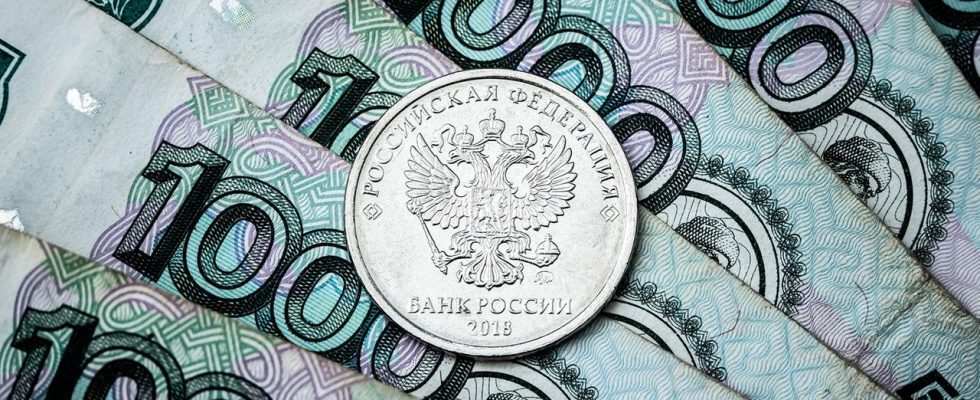For one ruble less than one US cent: The Russian currency has been falling for weeks and is at its lowest level since March 2022. This makes imports more expensive and inflation in Russia is rising.
The Russian currency continues its descent of the past few weeks. Today the ruble stood at 100.7 to the dollar and 110.2 to the euro. Over the year, it has lost around 25 percent against the dollar. This is the currency’s lowest level since March 2022, shortly after the start of military operations in Ukraine. In March last year, the ruble fell to a record low of 120 to the dollar.
The weak ruble makes imports more expensive. This in turn leads to rising consumer prices. At 4.3 percent in July, the inflation rate exceeded the 4.0 percent target set by the central bank. The central bank expects it to end up at 5.0 to 6.5 percent this year and not return to the stability goal until 2024. For comparison: In Germany, inflation in July was 6.2 percent.
Central Bank of Russia raises key interest rate
That is why the Russian central bank raised the key interest rate from 7.5 percent to 8.5 percent in July. According to Alexei Sabotkin, deputy governor of the central bank, growing demand for imports coupled with subdued export development is putting pressure on the ruble.
In order to strengthen the ruble, the central bank decided last week to stop buying foreign currencies until the end of 2023. In this way, the aim is to reduce fluctuations on the financial markets, according to a statement published last Wednesday. At the same time, however, they want to continue selling foreign currencies, which recently amounted to the equivalent of 2.3 billion rubles a day.
“The Kremlin wants a strong ruble”
At least in the short term, these measures have not been able to stop the downward slide. Therefore, there is already speculation about a further increase in key interest rates in September. The Interfax news agency reported today, citing the central bank, that an increase at the next regular meeting in September is possible. The likelihood of an interest rate hike in September is high, Deputy Central Bank Governor Sabotkin said last Friday.
Maxim Oreshkin, the economic advisor to President Vladimir Putin, stressed in a comment that the Kremlin wants to see a strong ruble and expects a normalization soon. This is seen as a possible sign that the central bank should take action ahead of its next scheduled interest rate meeting in mid-September. “The main reason for the weakening of the ruble and the acceleration of inflation is loose monetary policy,” Oreshkin wrote.
According to Oreshkin, a weak ruble complicates the structural change in the economy and has a negative impact on the real income of the population.
Trade balance is burdened
The president of the central bank, Elvira Nabiullina, on the other hand, made the deterioration in foreign trade conditions primarily responsible for the ruble’s weakness. The price cap on crude oil imposed by western industrialized countries has led to a sustained decline in export earnings. Although Russia sells more oil to other countries such as China or India, it has to accept deductions from the world market price. This weighs on the trade balance.
According to a preliminary estimate by the Central Bank of Russia on Aug. 9, the current account surplus of Russia’s balance of payments for January-July 2023 is $25.2 billion. This is significantly lower than in the corresponding period of 2022, when the surplus was reported to have been $ 165.4 billion.
of Russia Budget deficit increases significantly
In addition, the Russian budget deficit is increasing, as shown by data for the period from January to July this year. The deficit was 2.82 trillion rubles, the equivalent of $29.3 billion, or 1.8 percent of gross domestic product (GDP), the Russian Ministry of Finance announced last week, citing preliminary estimates.
For the first seven months of last year, Russia reported a budget surplus of 557 billion rubles. According to the preliminary data, expenditure increased by 14 percent while revenue shrank by 7.9 percent.
In the period from January to July, revenue from outside the energy sector increased by 19.8 percent year-on-year. But earnings from Russia’s top exports, oil and gas, fell 41.4 percent. The Ministry of Finance justified this with lower crude oil prices and natural gas exports, both of which are directly affected by the sanctions from the West. According to the ministry, however, Russia is on track to surpass the baseline target for full-year energy revenue of eight trillion rubles.
Russian economy is growing again
Meanwhile, according to official figures, the Russian economy grew again in the spring. The gross domestic product (GDP) increased in the second quarter by 4.9 percent compared to the previous year. Earlier, the Russian economy had contracted for four consecutive quarters year-on-year.
However, growth will be supported primarily by government spending. Spending on the war against Ukraine has increased. This supports industrial production. Private consumption is boosted by increased social benefits and higher wages. However, the growth data did not support the ruble.

